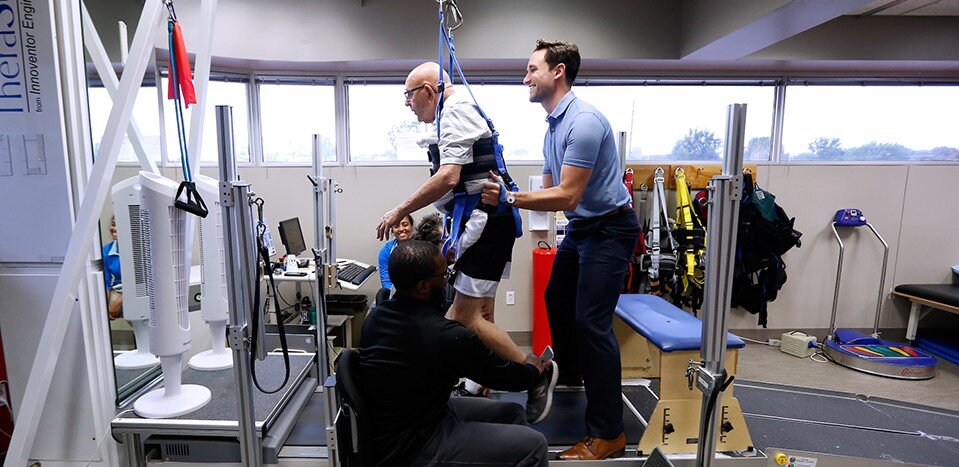As the physical therapist serving music students at her alma mater, Amber Lisowe knew what question was coming first. She answered it before it was even asked.
“No, I don’t have any musical skills. None whatsoever.”
Her patients at Lawrence University don’t really care. They are less concerned with any musical predisposition she might share with them and more interested in the skills she brings diagnosing and treating their musculoskeletal issues.
And those issues can be considerable.
“These students are practicing and playing for hours, every day,” said Lisowe. “Imagine being in these athletic positions, using your arms and hands, your back, for that long.”
Her use of the term “athletic” is deliberate.
“There are a lot of similarities between collegiate musicians and their counterparts on the field,” Lisowe said. “Both are passionate, and both deal with injury.”
While Lisowe might deem her history of musical pursuits minimal, her athletic undertakings were anything but. A multisport athlete in high school, Lisowe went on to play basketball at Lawrence. As with many athletes who follow the path toward a career in the medical sciences, Lisowe was familiar with injury.
“At Lawrence, I tore my ACL,” said Lisowe. “Twice.”
The first happened early in her freshman season, a devastating blow but one she was determined to overcome. An ACL tear is a season-ending injury with a rehabilitation period of 9-12 months, but Lisowe was passionate about her sport and getting back to it as quickly as possible.
There’s a period of mourning, Lisowe says, that can last until you’re back on the hardwood. The rehab process means you don’t get back to practicing on the court for a full five months. By this time, any concerns of re-injury were the furthest thing from her mind.
“I’d already done running things in therapy, some jumping and cutting, so by the time you get a ball in your hands, your body just kind of takes over and falls into those routines,” Lisowe said. “When you’re back to playing competitively, your focus has shifted from thinking about the leg itself to the dynamics of the game.”
Lisowe would tear her other ACL in her senior year.
“With the first injury, I knew I could work hard and return for my sophomore season. This time there was no next season for me. Definitely a big thing,” she said.
Those serious injuries led to firsthand physical therapy experiences, which in turn kindled Lisowe’s burgeoning interest in the field. Following Lisowe’s time at Lawrence (she graduated with her Bachelor of Arts from Lawrence in 2014), she went on to earn her Doctor of Physical Therapy degree from Rosalind Franklin University of Medicine & Science. She joined Advanced Physical Therapy soon after to work in their Neenah clinic.
The opportunity for Lisowe to work with Lawrence University Conservatory of Music students happened when LU’s longtime physical therapist, Advanced PT’s Phil Sorensen, looked to cut down on his hours. Lisowe jumped at the chance to return to Lawrence.
“Coming from a smaller town, Lawrence was such a great place for me to find myself,” said Lisowe. “The growth and experiences I had there, the friendships I made, really helped shape who I am today. Athletics got me on campus, but the academics and everything Lawrence offers is what really drew me in.”
Lisowe now finds herself at Lawrence one hour a week, providing physical therapy sessions for her student-patients. She sees a range of musicians—freshmen to seniors, flute to clarinet, oboe to piano—with a variety of orthopedic issues.
“A lot of what I do is helping them to manage their pain, figure out what’s causing it, getting them stronger and finding the best positions to hold their instrument,” she said. “There’s not a certain group of people that appear to be more at risk. I enjoy training and teaching them all.”
Sorensen, who worked with LU’s music students for nearly a decade, describes the experience there as unique.
“There’s just such joy there. These students will walk out of a session and begin playing their horn, and stuff like that. It’s just a really cool atmosphere. It makes you young again.”
Lisowe too recognizes the special nature of the gig, one that gives as much as it gets.
“I just love being back here. I think it was meant to be,” she said. “I love being able to make a difference for such a diverse group of talented individuals.”
Mentioning the variety of students she helps, Lisowe notes the common trait all these musicians possess. And despite being “non-musical,” it’s a characteristic she shares with them, as demonstrated throughout her athletic career.
“They are all very motivated to get better so they can continue doing what they love,” said Lisowe.
Click here to learn more about Amber and Phil and the clinics they serve at in addition to their responsibilities at Lawrence.




